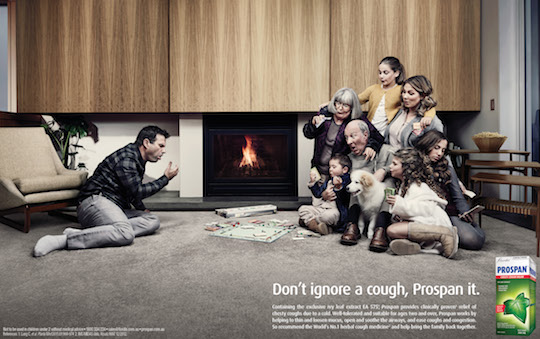How category insight and the world’s first cough predictor drove a healthy campaign
Share
Through category insights, data breakthroughs, a cough-prediction algorithm, Prospan was able to boost sales and reach.
This article originally appeared in The Experience Issue, our February/March 2018 print edition of Marketing magazine.
Campaign: Don’t ignore a cough
Client: Flordis
Agency: Affinity
Background
 Prospan is a natural cough remedy, suitable for young children, and is marketed by Flordis, a natural medicines company. For the winter of 2016, we predicted when children all around Australia were going to have cough symptoms, on a suburb-by-suburb level, and turned on our advertising to their parents only then. Our approach was driven by three challenges.
Prospan is a natural cough remedy, suitable for young children, and is marketed by Flordis, a natural medicines company. For the winter of 2016, we predicted when children all around Australia were going to have cough symptoms, on a suburb-by-suburb level, and turned on our advertising to their parents only then. Our approach was driven by three challenges.
Minimal budget
The cough, cold and flu category is dominated by pharmaceutical giants with huge marketing budgets. The 13 major brands that make up the monitored cold and flu category spent approximately $25 million in 2016. The total budget for Prospan weighed in at less than 1% of the overall market.
Busy parents
As they are the primary caregivers, time-poor, hard working mothers of young children were our core target. There’s been plenty of confusion in recent years regarding efficacy and safety, making mums less willing to consider children’s cough remedies. Cutting through their busy day in a low-interest category was a challenge.
Unseasonal weather
Incidents of coughs increase in the lower temperatures of the winter and so does the amount of cough remedy marketing. However, 2016 was the hottest year on record.
Objectives
The overall objective was to maintain continuity of sales, particularly in the peak cold season from May to July. The goal was modest, given it was the first year in which Flordis had acquired Prospan distribution rights for Australia (from Engelhard). During the key winter season, goals were: achieve an effective reach of one million mums with children under 12, nationwide, with an average frequency of 26 views per individual audience member.
Based on initial projections and budget, our activity was predicted to span from May 2016 to July 2016 – 76 days total coverage.
Strategy
We had to outthink the bigger players – and target people disinclined to buy our product – with a completely different approach. We sought to understand the existing behaviours of our target market. Instead of bludgeoning them with efficacy claims, we used data to leverage what they were already doing at the perfect moment.
A category insight: parents ignore coughs
To better understand how mums were managing coughs, we analysed the language they were using when seeking solutions. Using social and search data, our analysts found that initial posts in both social media and mums’ forums (82% of cough questions) followed two key themes: ‘How long should I wait before…’ or ‘I’ve ignored it for three days but…’. We identified a behavioural norm that many children’s coughs were ignored and going untreated. We explored this insight further.
Doubt
Qualitative research with our target mums revealed that most coughs went untreated because of a belief that coughs ‘sort themselves out’ over time. But as our language analysis showed, this period of waiting out the cough was riddled with doubt. This waiting period was the window of opportunity for Prospan to join the conversation with our clear message: ‘don’t ignore a cough’.
Perfect timing
Our research told us that mums would only be receptive to Prospan when their child actually had a cough. To succeed, we needed to predict when children would have a cough.
Humour as a weapon against inertia
Parents hate to be lectured, especially when it comes to their children, so we knew not talk down to them or create guilt. Instead, we used humour.
Execution
Peak doubt
We set about predicting when each child would come down with a cough: ‘peak mother doubt’.
Data breakthrough
Our analysts noticed a behavioural trend in search and social data: social posts and search queries were clustered over the span of as little as two days, rather than consistently over the entire winter period.
We could have used this intent signal as a trigger, but the only channel we could use it in would be search, a challenging channel to communicate an emotive message. To expand our reach, we needed to find a way to predict when mums would start to get worried that their child had come down with a cough.
Scientific approach
We then worked to get a better understanding of the perfect conditions for a cough. Rhinovirus, a key cough trigger, thrives in colder conditions, which also dampen our immune systems. We then overlaid various data (including temperature, pollution and Medicare) from across Australia and used a multivariant model to test thousands of inputs to set about building a predictive engine for illness – a Cough Prediction Algorithm. Following regression modelling, we were able to predict 48 hours in advance when the right conditions would be met, with an accuracy of p=0.0001 – in layman’s terms, a roughly one-in-9999 chance of the tested algorithm being wrong.
We then validated the model to make sure it held regardless of macro factors, such as epidemics or climate change.
The world’s first cough predictor
We found a cold snap is all it takes to get a cough, but how cold that snap needs to be differs based on your location. For example, people in Tasmania need a greater temperature change than Queenslanders because they’re used to colder weather.
This was much more complex than setting our programmatic buying platforms to turn on at certain temperatures by suburb: it was a matter of relative difference on an individual geographic basis. Applying a simplistic temperature trigger would have thrown away around 31% of our budget. We developed an algorithm to mathematically express how environmental factors affected actual behaviour of real people. It harnesses ad tech and media in real time, location by location.
With weather data imported in real time, media purchasing decisions could be made every five minutes, to control exactly when to turn our message on and off at a suburb level.
We selectively chose to run the campaign in all the suburbs where Prospan had strong distribution. As the temperature dropped just enough to get kids coughing, Prospan was there, suggesting that mums shouldn’t keep ignoring that cough. We kept our message simple, with a charming, direct problem/ solution approach.
‘Coughees’ were made to be victims of the cougher as everyone tried to get on with life. The levity of each of the exaggerated scenarios worked to offset the seriousness of the call to action. Our highly targeted digital media plan included banners, search and social (92%), as well as a small amount of trade print and in-store (8%).
Result
Unbeknown to us at the time of planning, 2016 was the warmest year on record. The recorded average temperatures didn’t reach the ‘peak illness zone’ across Australia. As a result, the entire cough medicine market declined by 8.5 percent in the six months to October 2016. Still, the perfect message was delivered at the right time through a combination of finding and leveraging existing behaviours, and using big data to build a predictive algorithm.
- Having only just taken over marketing with no historical data or assets, we achieved a 27 percent increase in retail sales during the cold season.
- Over six months, sales of Prospan grew by 10 percent, while the total market declined by 8.5%, giving Prospan an 18.5% growth in market share.
- There was an effective reach of 1,140,000 mums with children under 12, with an average frequency of 42.6, an increase of 14% and 63.8%, respectively.
- A weather-polling app and predictive cough algorithm enhanced engagement with a 54% increase in CTR (click- through rate).
- Media costs were reduced by 67%. This enabled us to double our coverage over the entirety of the winter months – 138 days in total.











